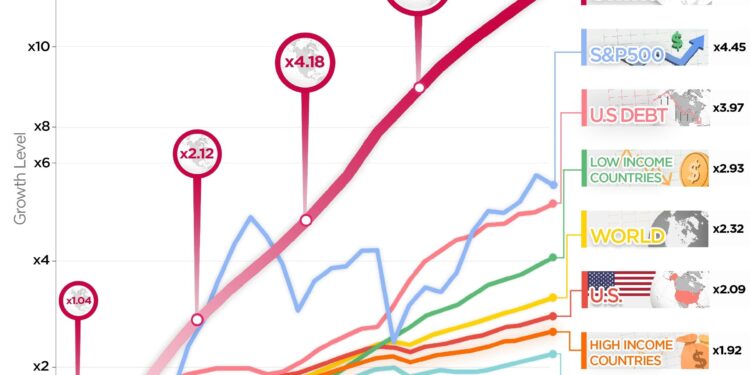China’s economic trajectory continues to wield significant influence over global markets, shaping trade dynamics, investment flows, and financial stability worldwide. In this analysis, U.S. Bank delves into the complexities of China’s economic growth, policy shifts, and emerging challenges, examining how these factors reverberate across international markets. As tensions persist between major economies and global supply chains evolve, understanding China’s role remains critical for investors, policymakers, and businesses navigating an increasingly interconnected financial landscape.
China’s Economic Growth Trends and Their Implications for Global Trade
China’s recent economic trajectory reveals a nuanced landscape shaped by both domestic reforms and external pressures. After decades of rapid expansion, growth has moderated, steering towards a more sustainable, consumption-driven model. This shift is evident in the increased emphasis on technological innovation, green energy investments, and urban consumption, allowing China to weather global uncertainties more effectively. However, challenges such as supply chain disruptions and geopolitical tensions continue to inject volatility, particularly affecting export-dependent industries. The ripple effects extend beyond borders, influencing commodity prices, manufacturing hubs, and global investment flows.
Key implications for global trade include:
- Recalibration of supply chains: Multinational companies are diversifying sourcing away from China to mitigate risks.
- Shifts in trade partnerships: Regional trade agreements like RCEP bolster China’s integration with Asia-Pacific economies.
- Commodity market fluctuations: China’s demand heavily impacts raw material prices, influencing global market stability.
| Sector | Growth Rate (2023) | Trade Impact |
|---|---|---|
| Technology | 7.5% | Increased exports of semiconductors and AI components |
| Manufacturing | 3.2% | Moderate growth, with supply chain diversification ongoing |
| Green Energy | 12.1% | Rising global demand for solar panels and EV batteries |
Assessing the Impact of China’s Financial Policies on International Markets
China’s recent financial policies have sent ripples across global markets, underscoring the nation’s pivotal role in international finance. With targeted regulations aimed at stabilizing domestic credit and managing debt levels, Beijing has effectively influenced capital flows, currency valuations, and investor confidence worldwide. These measures, particularly the tightening of capital controls and strategic interest rate adjustments, have prompted shifts in foreign exchange reserves and triggered recalibrations in emerging market bonds and equities. Investors and policymakers alike are closely monitoring how these policies interplay with global inflation and supply chain dynamics.
Key elements shaping this impact include:
- Regulatory tightening: Enhanced scrutiny on the tech and real estate sectors has led to revaluation of assets linked to China.
- Currency interventions: Managed fluctuations of the yuan aiming to support export competitiveness.
- Debt management: Efforts to deleverage state-owned enterprises affecting credit markets abroad.
| Policy Action | Global Effect | Market Response |
|---|---|---|
| Capital Controls Tightening | Reduced Cross-border Capital Flow | Volatility in Emerging Market Currencies |
| Interest Rate Adjustments | Influenced Global Bond Yields | Shift towards Safe-haven Assets |
| Debt Risk Management | Decreased Exposure to Chinese Corporates | Pressure on Global Credit Spreads |
Strategic Recommendations for U.S. Investors Navigating China’s Economic Landscape
U.S. investors should prioritize a diversified approach when engaging with China’s evolving market. Given the current regulatory environment and shifting geopolitical landscape, a balanced portfolio that spreads exposure across sectors such as technology, consumer goods, and renewable energy can help mitigate risk. Additionally, favoring companies with strong local partnerships and transparent governance structures will be crucial to navigate uncertainty effectively. Investors must also stay attuned to macroeconomic indicators, including China’s monetary policy adjustments and export trends, to anticipate market movements and recalibrate strategies promptly.
Proactive risk management remains key amid rising volatility. Combining on-the-ground insights with cutting-edge data analytics enhances decision-making accuracy. Financial advisors recommend the following strategic actions:
- Monitor ongoing U.S.-China trade negotiations and their impact on tariffs
- Engage with Emerging Tech and green energy sectors aligned with China’s 2060 carbon neutrality goals
- Leverage exchange-traded funds (ETFs) focused on Chinese equities for liquidity and flexibility
- Evaluate currency risk and consider hedging solutions to protect capital
| Sector | Growth Outlook 2024 | Risk Level |
|---|---|---|
| Technology | Moderate to High | Medium |
| Consumer Goods | Steady | Low to Medium |
| Renewable Energy | High | Medium |
| Financial Services | It looks like the last row in the table is incomplete. Here’s the missing part for the “Financial Services” row, completed and formatted consistently with the rest: | |
| Financial Services | Moderate | Medium to High |













![[News] Japan Develops 10nm Nanoimprint Technology, with Potential to Tackle EUV Bottleneck – TrendForce](https://earth-news.info/wp-content/uploads/2025/12/329851-news-japan-develops-10nm-nanoimprint-technology-with-potential-to-tackle-euv-bottleneck-trendforce-360x180.jpg)









![[News] Japan Develops 10nm Nanoimprint Technology, with Potential to Tackle EUV Bottleneck – TrendForce](https://earth-news.info/wp-content/uploads/2025/12/329851-news-japan-develops-10nm-nanoimprint-technology-with-potential-to-tackle-euv-bottleneck-trendforce-120x86.jpg)






